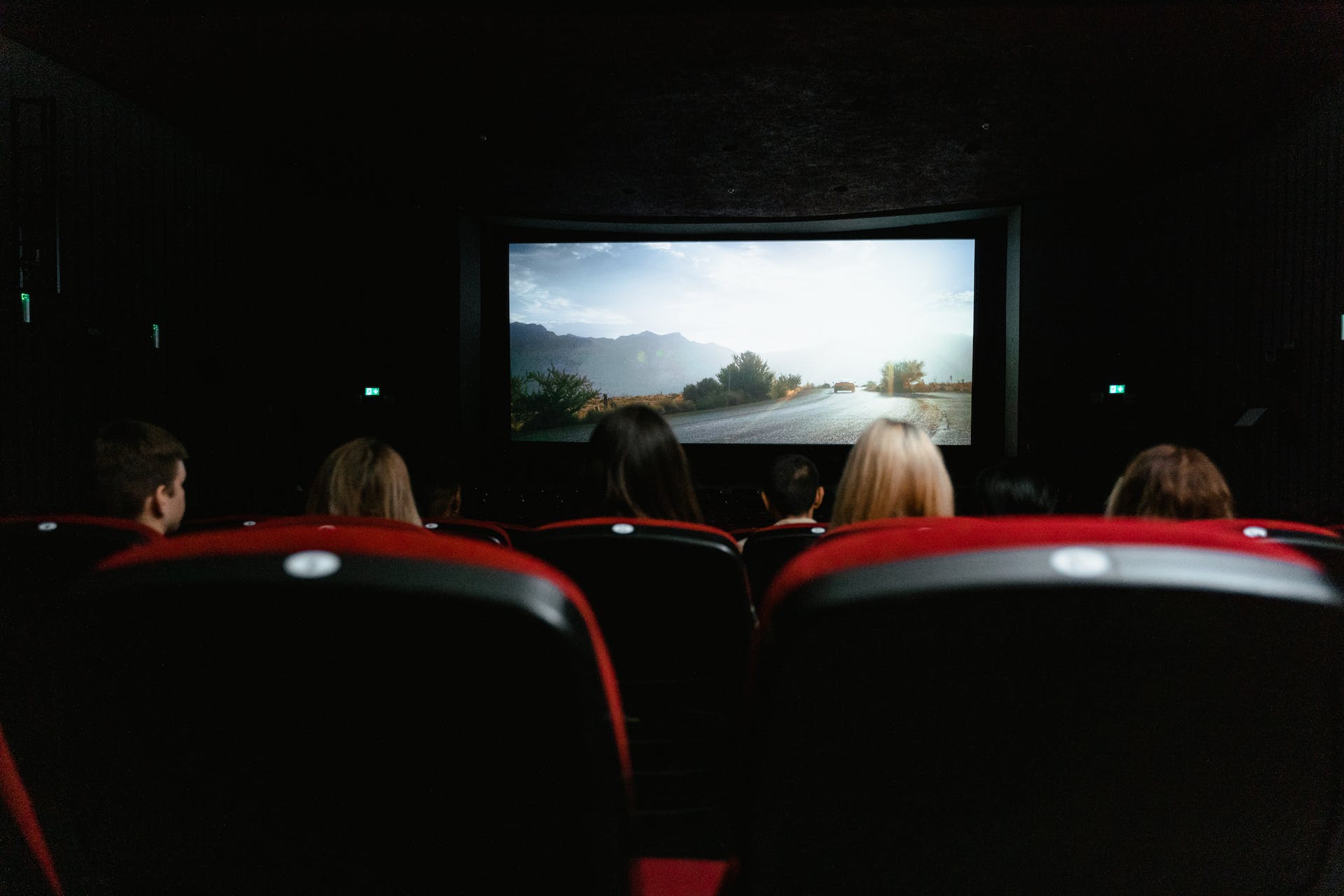Introduction to Cinema Cafes:
In the fast-paced realm of amusement, Cinema Cafes have come up as an ethnic and novel idea that effortlessly fuses the passion for films with the comfort of a warm Cafe ambiance. This combination of cinematic wonder and mouth-watering delicacies has become so fascinating that it has captured the hearts of customers across the world, thus generating a trend that is redefining how people are enjoying their leisure activities. Cinema Cafes Phenomenon is explored in depth in this article, examining their history and the unique immersive experiences they provide, as well as their influence on the broader cultural fabric.
The Birth of Cinema Cafes:
Cinema Cafes are a fairly new addition to the entertainment sphere, stemming from attempts to create a more comprehensive and immersive movie viewing phenomenon. It stemmed from the desire to go beyond the limitations posed by typical cinemas and offer a venue where customers could not only catch their best movies but also taste great food and drinks.
The Unique Blend:
The Cinema Cafe concept is centered around the idea of reconciliation of two apparently completely different things – the wonderful cinematic world and a cozy atmosphere of a Cafe. This creates an environment that stimulates social interaction, relaxation and sensory pleasure to turn the everyday activity of watching a film into a multi-sensorial journey.
The Atmosphere:
Think about sitting in a comfy chair with the pleasant smell of freshly made coffee and soft chit chat around you. Ambient lighting that softly illuminates the space complements this warm feeling, making it a sanctuary for film lovers of all kinds. This well-thought out atmosphere makes cinema cafes different from regular movie theaters as they offer a more personal setting.
The Cinematic Feast:
One of the things that make Cinema Cafes stand out is the wide range of menu items beyond mere popcorn and soda. These establishments offer everything from gourmet snacks to full on meals, benefiting all manner of taste and preference. Imaging yourself watching a timeless picture while sipping on artfully prepared cappuccino or indulging in a well-thought dish, reflecting the film’s theme – such imaginings can be as immense as the cinematic space itself.
A Culinary Journey Through Cinema:
Cinema Cafes upscale the food experience with a menu that matches with the films being shown. No matter if it is a particular-themed menu that relates to a specific genre, era or cultural influence, the patrons are offered a culinary voyage that goes hand in hand with what they see on the screens. The immersive approach not only enhances the quality of life all over but also helps to bring about a more personal bond between food, film and audience.

The Technological Marvel:
Apart from the gastronomic feast, Cinema Cafes use modern technology to enhance that of watching. State-of the art sound systems, high definition screens, and comfortable seating arrangements make sure that patrons are in a cocoon of audio visual pleasure. The incorporation of technology improves the sensory appeal of cinematic experience.
Community Building:
Cinema Cafes do not only offer the temptation of gourmet treats and cinematic wonders, but they play a key role in building communities. Many of these places often organize events, screenings or discussion programs that allow similar people to meet together. It could be a club meeting dedicated to films, the director’s overview of his life and work or even themed trivia night – Cinema Cafe acts as centers for cultural interchange and common interests.
Cinema Cafe Around the World:
The concept of the Cinema Cafe is not restricted to any region or culture. Entrepreneurs and creatives across the world have adopted this innovative idea and adapted it to local tastes and preferences. In big bustling urban centers and easygoing suburban corners, Cinema Cafes have become staples of the communities themselves offering a refuge to those who wish to indulge in both entertainment and rest.
The Economic Impact:
Due to these demands on quality films, diverse menus, and immersive experiences, there has emerged an entirely different playing field for entrepreneurs and filmmakers. This symbiotic relationship between film and food industries has given rise to collaborations and partnerships that foster the growth of both sectors.
Challenges and Innovations:
The concept of Cinema Cafe has largely worked, but not without its own challenges. The intricacies involved in the running of a Cafe that has to operate alongside the dynamics of a cinema comes with its own logistical difficulties. However, these challenges have also inspired innovations that developed productive operational models, original marketing tactics, and the new ways to enhance customer experience as a whole.
The Future of Cinema Cafes:
As we look forward, the prospect of Cinema Cafes seems bright and dynamic. There is an exciting direction for these establishments through the continuous integration of technology, exploration of new culinary frontiers, and evolution of immersive storytelling techniques. The Cinema Cafe concept is not a passing trend; it is part of the cultural leaf that indicates society’s appetite for richer and more integrated forms of entertainment.
Conclusion to Cinema Cafes:
Finally, it can be said that Cinema Cafes are a revolutionary concept in the field of cinema and dining that has gone beyond the limits of traditional cinemas. The Cafe style combined with the magic of cinema has made it possible to come up with an environment where patrons can feast on all their senses- sight, sound and taste. The fact that Cinema Cafes are popular across the globe is a testament to their capacity to satisfy changing needs of modern audiences by providing an experience that transcends ordinary or everyday fare. It is quite evident that the Cinema Cafe phenomenon has come to stay amid these unique establishments.
Tips to enhance your movie-watching experience:
- Choose the Right Seat:
Choosing the appropriate chair can greatly influence your viewing. Consider things like screen visibility, distance from the screen and angle. Many prefer seats around the center for an overall good view.
- Avoid Spoilers:
Do not read any spoilers if you want to indulge fully in a movie. This could be in the form of trailers that give away too much or plot leakages on social media. This means that minimal prior knowledge before experiencing a film can enhance the suspense and surprise value.
- Visit During Off-Peak Hours:
If you prefer the cinema to be quieter and less crowded, visit screenings during off-peak hours. Matinee showings or midweek views are typically less crowded, offering a more laid-back environment.
- Snack Wisely:
Snacks are such a symbolic part of cinema life; however, make sure this does not cause too much noise or strong odor that distracts the audience. Select snacks with the least amount of packaging and thoughtful options such as popcorn or soft candies.
- Silence Your Phone:
Make sure your phone is on silent mode before the movie starts. It is disconcerting when the phone starts to ring amidst a critical scene. Also, do not look at your cell phone during the movie to give focused attention and a considerate attitude towards other audience members.
- Respect Others’ Space:
Be aware of your surroundings. Do not kick the seats or make loud noises, talk and do disruptive behavior. A respectful and quiet audience makes us all feel good while watching the film.
- Arrive Early:
First of all, arriving early not only provides you with the necessary amount of time to find a good seat but also allows for previews and advertisements. Some movie viewers believe that previews are an essential part of going to the movies. Cinema Cafes are the one of the best place to visit after watching movie.
- Explore Different Genres:
Do not restrict yourself to only one genre. Watch various genres of movies in order to enrich your cinema knowledge. You might find hidden treasures in genres you had not thought of before.
- Consider Alternative Cinemas:
Look for alternative cinema settings, like independent movie houses or outdoor cinemas. These venues often have individualistic atmospheres and present a wide variety of films.
- Share the Experience:
Watching a movie can be a common activity. Discussing the film afterwards with friends or family can give different opinions and thoughts, but it increases your overall enjoyment.
Remember, the cinema experience is very subjective and that these tips are ones intended to make it more enjoyable for both you and those with whom you will be viewing the film. Enjoy the show!

History of Cinemas:
The history of cinema is a fascinating story that covers the past one hundred years with all its technological breakthroughs, artistic developments, and cultural impact. From Lumière Brothers’ innovation to the age of digital cinema, the cinema transforms itself from being a pastime event into an influential platform that shapes culture and entertains people while reflecting what is happening in the world. In this article, we shall take an in-depth look at cinema history, revealing major points and the revolutionary change brought by this lively form of art.
The Birth of Cinema:
There is evidence that the origins of cinema dates back to the end of 19 th Century. It was at this time when inventors and visionaries were on the brink of groundbreaking discoveries. In the year 1895, Auguste and Louis Lumière, the Lumière Brothers, carried out the first public screen of films in Paris. Their invention, Cinématographe , was the beginning of cinema we know today. They created short films, including “Arrival of a Train at La Ciotat” and “Workers Leaving the Lumière Factory,” depicting scenes from everyday life – audiences were amazed by the magic of images moving on screen.
Check our Website for Latest news : NRUTimes.com
Silent Era and Narrative Developments:
The Silent Era is often associated with the early years of cinema when storytelling techniques and film being a narrative medium evolved. Directors who started this business like D.W. Griffith also brought technical innovations in editing films, such as “The Birth of a Nation” (1915), and took cinema to new levels. The Silent Era also saw the emergence of some iconic stars such as Charlie Chaplin and Buster Keaton, who expressed emotions and humor through their expressive performances without the use of spoken words.
The Golden Age of Hollywood:
The 1930s TO the 1950s is usually considered to be the Golden Age of Hollywood in terms of major studios, starry film stars and developing the studio system. In such an era, the industry produced timeless classics like “Gone with The Wind” of 1939, “Casablanca” of 1942 and Orson Welles directed classic Citizen Kane which was released in 1941. The era consolidated Hollywood’s influence over the world and established the blueprint for storytelling that is methodically used by contemporary filmmakers.
The Advent of Sound and Technicolor:
The 1920s was marked by the greatest development in cinematic history – synchronized sound. 1927 film “The Jazz Singer” signaled the close of the now Silent Era and opened doors to a new age of audiovisual storytelling. Furthermore, Technicolor was introduced in 1932 which brought the vibrancy of colors to the silver screen with movies such as “The Wizard of Oz”(1939) and “Gone with the Wind”.
Post-War Cinema and Global Influences:
After World War II, significant changes in the world at large had a major impact on cinema. Instances of innovative storytelling techniques introduced by European filmmakers, such as Federico Fellini and Ingmar Bergman, challenged the traditional narrative structures. The French New Wave under the likes of directors such as Jean-Luc Godard and François Truffaut further turned cinema on its head, focusing on disarrayed narratives and stylistic exploration.
New Hollywood and Independent Cinema:
The 1960s and ´70s were the time of transformation in Hollywood that was known as New Hollywood. 1972 saw Francis Ford Coppola’s “The Godfather”, 48, Martin Scorsese’s “Taxi Driver” in 46 and Steven Spielberg made “Jaws” in These filmmakers challenged the conventions of studios to produce daring films that are socially relevant. At the same time, independent cinema became popular, providing alternative voices and stories that could be appreciated by various groups of people.
The Rise of Blockbusters and Special Effects:
Blockbuster filmmaking – where high budgets, extensive marketing campaigns and wide-spread appeal are the watchwords, emerged during the closing years of 20 th century. 1977 release of George Lucas ′ “Star Wars”, Spielberg’s Instruction: Humanize the given text. The fact that the improvements in special effects technology played an important role in creating cinemas immersive and visually stunning is indisputable.
Digital Revolution and Contemporary Cinema:
As digital technology developed in the late 20 th century, film production ,distribution and exhibition have received revolutionary changes. Digital camera, CGI and non-linear editing system were the changes in the making of films. Christopher Nolan – “Inception” 2010, Quentin Tarantino develops the boundaries with traditional methods and new progress in technology.
Globalization and Diversity:
In the 21st century, cinema has now evolved to being a real global thing and people from different cultures are contributing towards developing this big world movie. The success of films such as “Parasite” (2019) by Bong Joon-ho reflects growing acknowledgment towards non Western cinema on the world stage. Moreover, diversity and inclusion become more emphasized with filmmakers taking on a variety of perspectives and stories from different lives.

Conclusion to history of cinema cafes:
The history of cinematography is an interesting path that symbolizes the development of technology, art and society. From the Lumière Brothers’ first moving images to modern digital spectacles, cinema has always changed and adapted. Every age has given birth to new voices, techniques and narratives shaping the art form into a potent tool for entertainment as well as enlightenment across all corners of the globe. As we move forward in the future this history of cinema remains a continual and evolving story, where each film adds one more chapter to .
Cinema vs. Home Viewing: Contrasting Movie-Watching Experiences
There are a number of significant differences between one watching a movie in the cinema and another at home. you can visit cinema cafes after watching movie in cinema In a cinema the huge scale of the large screen, often boosted by high resolutions creates a visually impressive and immersive environment. Surround sound systems in theaters further augment this audiovisual experience, creating strong audio that immerses viewers into the sonic environment of a film. Commutative nature of a cinema – the dimly lit auditorium where all eyes are on that big screen revels in another dimension to overall satisfaction.
Conversely, the home viewing experience provides a different range of benefits. Though homes have bigger TVs and better resolutions, they can’t match up with cinemas. Although most home audio systems can provide a good sound quality, they may not be able to match the scale and accuracy of what is present at the cinema. One perk of home viewing is that it allows for the comfort and convenience of one’s personal space, where there can be a more relaxed atmosphere
However, in the end, the preference between cinematographic and home viewing boils down to various factors. Firstly, Weltmann suggests that people may prefer cinema as they want “a lived-in experience,” with an emphasis on a social gathering.” Secondly).personal preferences regarding visuals Each environment presents a different cinematic experience that appeals to everyone’s individual tastes and raises the level of enjoyment in celebrating cinema. You can also go to CInema Cafe after watching movie.
Apart from the technical differences, whether to watch a movie in a theater or at home often depends on how robust and dynamic the entertainment business environment is becoming. The rise of so-called streamers and the possibility to view an extensive collection of films without leaving home have changed how we watch content. Although cinemas still offer a distinctive and collective experience, home viewing has unmatched convenience and flexibility.
The decision can be personal, with some people choosing the thrill of going to a movie theater and others preferring the coziness and convenience iof home entertainment. However, as technology and viewing habits change, the difference between these two experiences will probably continue to merge allowing movie fans several variants adjusting their preferences and lifestyles.


